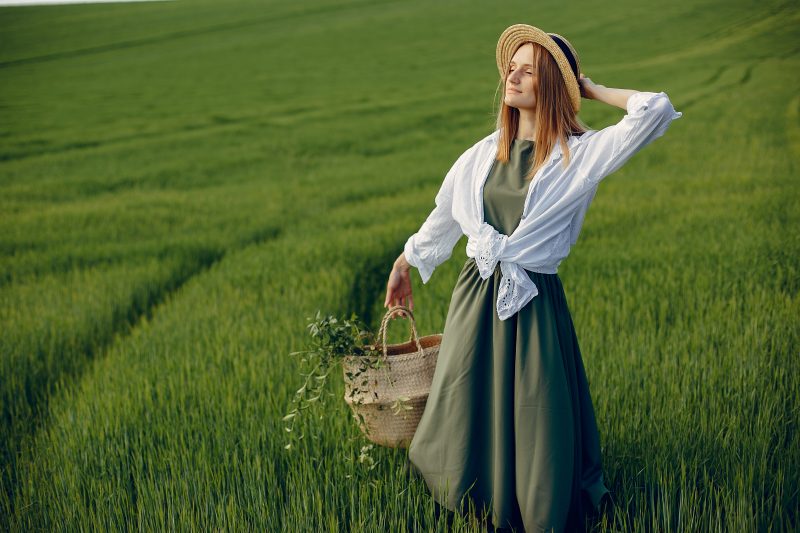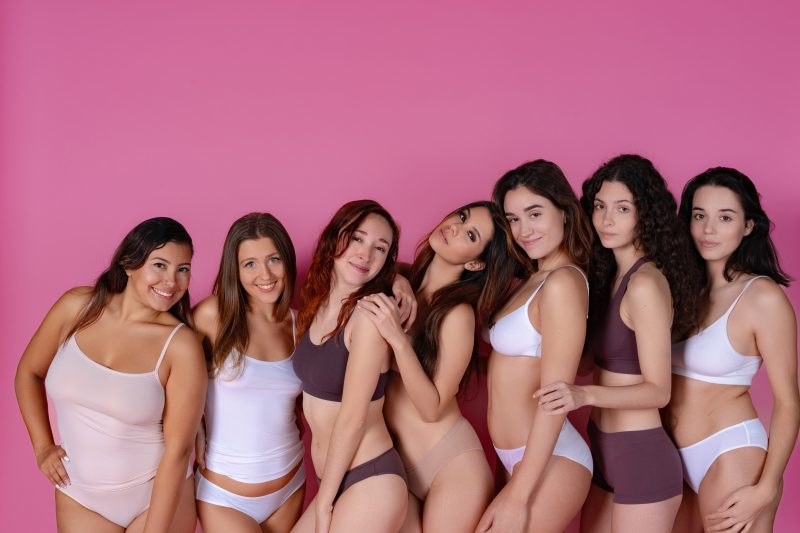Last month, I found myself at a fashion editor’s dinner in London, seated next to the creative director of a French luxury brand I won’t name (though their bags probably cost more than your car). As we picked at our elaborately plated starters, she leaned over and asked where my dress was from. The dress in question—a midi with an unusual abstract print in rich blues and greens—was from a small British brand called Palava, made using fabric from a textile mill in Lancashire. When I explained this, she nodded thoughtfully before confessing that her team had been looking to British textile producers for their next collection. “There’s something happening with British fabrics right now,” she said. “A renaissance of sorts.”
She’s not wrong. While Liberty prints have long been the standard-bearer for British textile design—those instantly recognizable floral patterns that scream “posh English eccentric” from twenty paces—there’s a broader revival happening in domestic fabric production that deserves our attention. A new generation of designers is rediscovering historic British mills, traditional techniques are being reimagined for contemporary fashion, and textile innovation is happening in unexpected corners of the UK.
This renaissance isn’t about nostalgia or heritage for its own sake, though tradition certainly plays a part. It’s about the growing recognition that British textiles offer something distinctive in a homogenized global marketplace—character, craftsmanship, and increasingly, credentials in sustainability that align with changing consumer priorities.
Let’s start in Yorkshire, where the woollen industry has deep historic roots but is finding new relevance through mills that have pivoted toward quality over quantity. Abraham Moon & Sons in Guiseley has been producing wool fabrics since 1837 and has survived by focusing on exceptional quality and design innovation rather than competing with mass production. Their fabrics now appear in collections from brands like Margaret Howell, Vivienne Westwood, and Paul Smith, who value their distinctive texture and color depth that machine-perfect global production often lacks.
What makes Moon’s fabrics particularly interesting is how they balance tradition and modernity. Using heritage looms alongside contemporary techniques, they create tweeds and wools with distinctive character that nonetheless work for modern silhouettes. Their lighter weight wools in particular have found favor with designers creating transitional pieces that work across seasons—addressing both changing climate conditions and the fashion industry’s gradual move away from strict seasonal collections.

Further north in Scotland, Johnstons of Elgin has undergone a remarkable transformation from traditional cashmere supplier to fashion-forward textile innovator. While continuing to produce exceptional cashmere and fine woolens using centuries-old techniques, they’ve also developed lighter weight, more versatile fabrics that work for contemporary wardrobes. Their experiments with cashmere blends—including unexpected combinations with linen or silk—have created textiles with the luxury of cashmere but greater versatility for today’s less formal dressing codes.
Johnstons now produces fabrics for numerous luxury houses including Burberry and Chanel, but they’ve also launched their own ready-to-wear collection that showcases their textiles in contemporary silhouettes. Their knitwear in particular demonstrates how traditional materials can be reimagined—oversized cashmere hoodies and relaxed cardigan coats that bring heritage fabrics into modern contexts.
The most unexpected textile revival, however, might be happening in linen. Once considered the slightly crumpled, worthy-but-dull option for summer clothes, British linen is experiencing a serious glow-up. Northern Ireland’s Baird McNutt, which has been weaving linen since 1912, has developed techniques that create softer, more fluid linens that drape beautifully and—crucially—don’t crease quite as dramatically as traditional versions.
This innovation has caught the attention of designers looking for natural, sustainable fabrics with less environmental impact than cotton. Brands like Reformation and Ninety Percent have incorporated Baird McNutt linen into recent collections, appreciating both its reduced environmental footprint and its more relaxed aesthetic that suits contemporary silhouettes. The fabric’s natural temperature regulation also addresses increasing consumer demand for versatile pieces that work across seasons and in unpredictable weather conditions.
What’s particularly exciting about the British textile revival is how it extends beyond these heritage players to include innovative newcomers.
Bristol Cloth, a relatively recent initiative, creates textiles using wool from sheep grazing just outside Bristol, natural dyes from plants grown locally, and weaving done within a 15-mile radius. Their “soil-to-soil” approach represents the next frontier in sustainable textiles—fabrics with transparency and traceability built into every stage of production.
The project emerged from growing consumer consciousness about textile waste and environmental impact, but has gained traction because the resulting fabrics are genuinely beautiful—rich, complex colors derived from natural dyes and textural interest from small-batch production methods. Small British fashion brands including Rabens Saloner and Phoebe English have incorporated Bristol Cloth into recent collections, finding that customers are increasingly willing to pay premium prices for garments with authentic sustainability credentials.
British textile printing is also experiencing a creative renaissance that goes well beyond Liberty’s iconic patterns. Glasgow’s Timorous Beasties has revolutionized printed fabrics with their surreal, slightly subversive take on traditional patterns. Their “Urban Toile” designs might look like classical toile de Jouy from a distance, but closer inspection reveals modern city scenes complete with gritty details—a cheeky commentary on decoration traditions that has found favor with both fashion and interiors designers seeking something distinctive.
London-based House of Quinn has similarly brought fresh energy to British textile design with their hand-printed fabrics that reference architectural elements and abstract art. Working with small-batch production methods that embrace the variations and imperfections of hand processes, they’ve created textiles with depth and character that stand apart from digitally perfect mass-produced alternatives. Their collaborations with independent fashion designers like Phoebe English demonstrate how these distinctive textiles can transform simple silhouettes into something special.
What connects these diverse textile producers—from centuries-old mills to new sustainability pioneers—is a focus on quality, character, and increasingly, environmental credentials. As fashion consumers become more conscious of the impact of their choices, the provenance and production methods of fabrics matter more than ever. British textile producers, with their emphasis on quality over quantity and their growing focus on sustainable processes, are well-positioned to meet these changing priorities.
The revival isn’t without challenges. British textile production remains significantly more expensive than mass manufacturing in Asia, and many historic mills have closed as brands pursued ever-cheaper production. Brexit has created additional complications for an industry that has always depended on import/export relationships. And small-scale, sustainable production inevitably means higher prices that not all consumers can afford.
Yet there are encouraging signs that the market is shifting to recognize the value of these fabrics. Mid-range brands like Toast, Margaret Howell, and Community Clothing have built successful business models that incorporate British textiles while remaining (relatively) accessible. Their customers are increasingly willing to pay more for fewer, better pieces with authentic stories and genuine quality—exactly what British textile producers offer.

Even more encouraging is how younger designers are embracing domestic textiles despite their higher costs. London-based Phoebe English has built her brand around British production and materials, finding that transparency about pricing and production helps customers understand the value proposition. Richard Malone, who won the International Woolmark Prize in 2020, regularly incorporates British wools into his sculptural designs, demonstrating how these traditional materials can fuel cutting-edge fashion.
For the average consumer, this textile renaissance offers an opportunity to invest in pieces with substance—garments made from fabrics with distinctive character that will actually improve with age and wear. A wool jacket from Abraham Moon or a linen shirt using Baird McNutt fabric might cost more than fast fashion alternatives, but will look better longer and carry less environmental guilt. As we all reckon with the true cost of our clothing habits, these qualities matter increasingly.
The French creative director who admired my British-made dress represented a broader shift in how global fashion views British textiles—not as fusty heritage elements but as distinctive, characterful components with both aesthetic and ethical appeal. As she put it while we waited for dessert: “British fabrics have soul. You can feel the hand that made them, the place they come from. That’s rare now, and valuable.”
So next time you’re considering a new clothing purchase, look beyond the design to the fabric itself. Is it from a British mill? Does it have the character and quality to improve with age? Does its production story align with your values? These questions matter not just for sustainability reasons, but because clothes made from distinctive, quality textiles simply bring more pleasure in wearing. They feel different, age better, and carry stories that disposable fabrics never could. In a world of increasingly homogenized fashion, that’s something worth seeking out—and worth paying for.



